|
|
|
|
Products mentioned in this Article
--None--
|
|
|
|
|
|
|
|
|
 |
|
|
The Birth of the Assault Gun Forces
After the battles on the Don River in 1942 the Hungarians undertook a comprehensive review of the state of their armoured forces. The lack of effective anti-tank power on the Don was recognised as well as the ineffectiveness of the Hungarian Toldi I and German supplied T-38 (Panzer 38(t)) tanks they were using.
In 1942 Hungarian vehicle manufacturer Manfréd Weiss proposed making an assault gun based on the chassis of the Turán medium tank. The proposed new weapon mounted a 105mm 40M howitzer. The design was accepted and named the Zrínyi II. A model armed with a long 75mm anti-tank gun was proposed as the Zrínyi I. The plans for the Zrínyi I were cut short in 1944 when the Manfréd Weiss factory in Csépel was bombed by American bombers on 27 July.
|
| 1st, 7th and 10th Assault Gun Battalions Actions in Hungary |
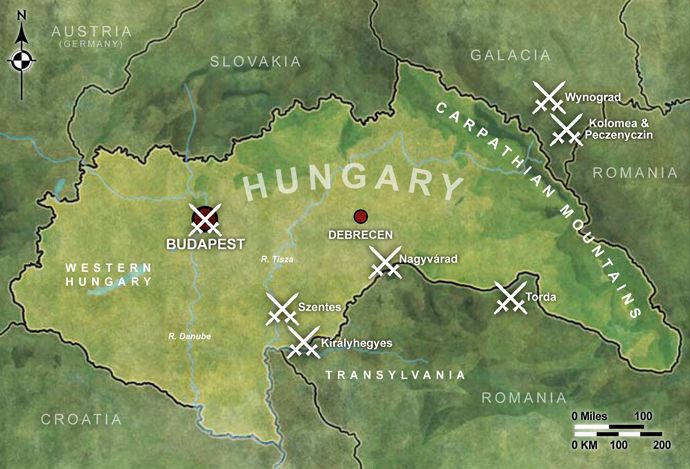 |
The Hungarian General Staff decided to form eight
assault gun battalions to support the infantry in October 1943. The
eight assault gun battalions were numbered the 1st, 7th, 10th, 13th, 16th, 20th, 24th and 25th in September 1944.
They were to be armed with the Zrínyi II assault howitzers, but not
enough could be produced, so some units received German StuG G or Hetzer
assault guns, while others got Turán tanks or 75mm anti-tank guns.
1. Rohamtüzér Osztály
(1st Assault Gun Battalion)
Battles: Galicia, Budapest.
Armament: Zrínyi II assault howitzers.
The 1st Assault Gun Battalion went into action with its full compliment of 30 Zrínyi II assault howitzers in April 1944
in the reserve of the Hungarian VII Corps in Galicia (modern Western
Ukraine). The Hungarian goal during the campaign was to seize the
railway junction at Kolomea. This would stop the Soviets getting access
to the passes that led over the Carpathian Mountains into Hungary.
|
 |
Soviet counterattacks halted Hungarian progress on 22 April after the Red Army rifle divisions they faced were reinforced by a tank brigade. The Red Army T-34 tanks ominously ground their way through the Hungarian lines, pushing back the Hungarian riflemen. The timely intervention of the 1st Assault Gun Battalion saved the day. They counterattacked and knocked out 17 T-34 tanks and help the 16th Infantry Division to recover their lost ground. More attacks by the assault guns followed and more attacks later in the day allowed the battalion to capture a village on the path to Kolomea.
On 9 July the 3rd Battery attacked Soviet positions at Peczenyczin in Galicia. During the attack one Zrínyi II assault howitzer had to be abandoned in a ditch in the enemy lines. The Battery’s commander, Lieutenant Tibor Rátz, led a successful raid to recover the assault gun.
|
Százados Józef Barankay
Captain József Barankay was already a veteran of the 1942 campaigns when he became commander of the 1st Assault Gun Battalion in 1944. An aggressive commander he led his battalion successfully during the fighting around Peczenyczin. The fanatical commander sold his flat before joining his unit at the front, saying ‘I don’t need it anymore’. He also maintained a grave for himself between the first two soldiers casualties of the battalion. He was killed in an air attack on his command on 13 July 1944. In August 1944 he was posthumously awarded the Officers’ Gold Bravery Medal for his leadership during the Galicia campaign. On 22 November 1944 the battalion was renamed ‘1. József Barankay Rohamtüzér Osztály’ (1st József Barankay Assault Gun Battalion) in his honour.
|
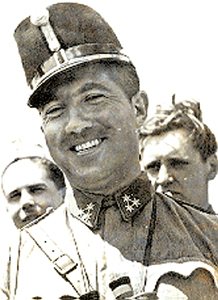 |
On 24 July the 2nd Battery ambushed three T-34 tanks at Wynograd. Later the same day they broke a Soviet rifle unit
encircling a Hungarian artillery battery. The 1st Assault Gun Battalion continued to fight with the Hungarian First Army
and eventually joined the 2nd Armoured Division fighting the rearguard actions for the First Army’s withdrawal into the
Carpathian Mountains. The 7th Assault Gun Battalion, armed with StuG G assault guns, joined the 1st Army in August to replace the 1st Battalion when it returned to Budapest for refitting and rest. It was latter caught inside the city after fighting around it to halt the encirclement. It fought with Group Billnitzer. |
| Zrínyi II Assault Howitzer |
|
Below: Engine Deck view.
|
Base Colour: Army Green (FWP342); Exhaust: Oxide Red (FWP382).
|
7. Rohamtüzér Osztály
(7th Assault Gun Battalion)
Battles: Carpathians, Transylvania, Tisza River, Budapest, Western Hungary.
Armament: StuG G assault guns.
The 7th Assault Gun Battalion replaced the 1st Assault Gun Battalion with the First Army in August 1944 after undergoing training in Germany with their new StuG G assault guns.
In late September they were moved from the northwestern border with the Ukraine to the Transylvania border to take part in the defence against the Soviet invasion. There, their 2nd Battery made a famous counterattack against the Soviet 18th Tank Corps near Királyhegyes, knocking out twelve Soviet T-34 tanks, but losing all nine of their StuGs. However, only three were completely destroyed and the others were recovered the next day.
|
 |
The 7th Assault Gun Battalion was next fighting on the Tisza River in the region of Szentes, Csongrád and Kecskemét,
taking a heavy toll on Soviet tanks before being almost destroyed in October at the Szentes bridgehead. The remaining
ten StuG G assault guns were placed in reserve with the Hungarian 3rd Army.
During its battles on the Tisza River the battalion destroyed 67 tanks and 14 other vehicles.
After the battle of the Szentes bridgehead the battalion was withdrawn to Budapest where it fought with Group Billnitzer.
|
StuG G Assault Gun
Base Colour: Panther Yellow (FWP365).
|
Camo Colours: Boot Brown (FWP323); Army Green (FWP342).
|
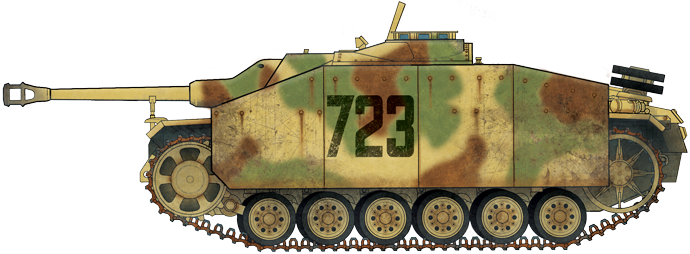 |
10. Rohamtüzér Osztály
(10th Assault Gun Battalion)
Battles: Transylvania, Nagyvarad, Budapest.
Armament: Zrínyi II assault howitzers.
The battalion first saw combat in Transylvania and fought alongside the 2nd Armoured Division, supporting the 25th Infantry Division during the fighting for Torda in September. During one encounter six Zrínyi II assault howitzers
of the 2nd Battery under Ensign János Bozoki ambushed and knocked out 18 T-34 tanks in just a few minutes. Later he led a mission into enemy lines to recover three damaged Zrínyi II assault howitzers of his battery. For this action he was
awarded the Officers’ Gold Bravery Medal. They were joined in the action by four Zrínyi II assault howitzers of the 1st Battery, which helped push the Soviets out of the village of Sosfurdo and saved the city of Torda from being encircled on
that day.
The 10th Assault Gun Battalion next became embroiled in the fighting for Nagyvarad and were one of the first units
to arrive and setup the defence of the city. They only had three operational Zrínyi II assault howitzers at the time, so most of the battalion fought on foot as infantry.
|
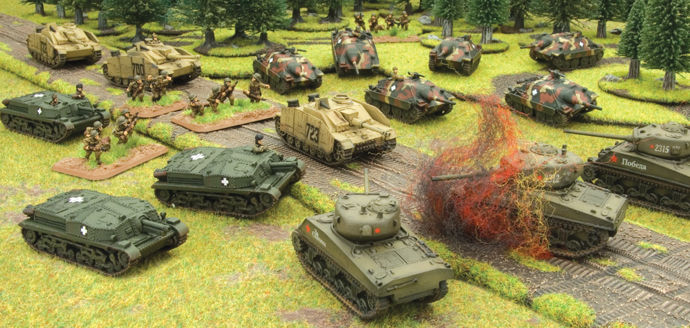 |
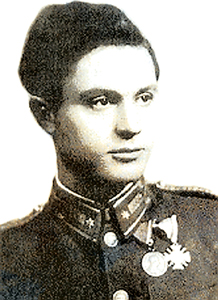 |
During the battles for Budapest the battalion fought inside the city as
part of Group Billnitzer. The 10th Assault Gun Battalion’s Zrínyi II
assault howitzers were heavily engaged in the fighting for the city.
During one counterattack, to push the Soviets out of the Baracska suburb on 8 December 1944, the
battalion commander Captain Sándor Hanák drove his Zrínyi over a firing
anti-tank gun. The battalion knocked-out or captured 15 anti-tank guns
during the attack.
Hanák was back in action again on 7 January 1945 leading an attack to
recapture the temporary air field on the ‘New’ racecourse. Supported by
German troops the attack knocked out a battalion of Soviet infantry.
However, Hanák’s battalion was forced to withdraw because they didn’t
have enough supporting infantry to hold it from the advancing Soviets.
Left: Zászlós János Bozoki.
|
Zrínyi II Assault Howitzer
Base Colour: Army Green (FWP342); Camo Colours: Battlefield Brown (FWP324); Sicily Yellow (FWP362);
Exhaust: Oxide Red (FWP382).
|
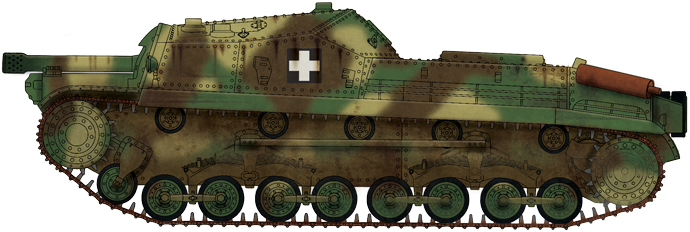 |
Group Billnitzer
Battles: Budapest
Armament: Zrínyi II assault howitzers, StuG G assault guns, Jagdpanzer 38(t) ‘Hetzer’.
The remnants of six assault gun battalions were committed to the defence of Budapest and were trapped inside when the city was encircled. The assault artillery troops were formed into a battlegroup under the command of Lieutenant-General Erno Billnitzer, known as ‘Uncle Bill’ to his men, consisting of 2000 men, 30 assault guns (StuG G, Zrínyi, and Hetzers) and eight 75mm anti-tank guns. Many of the men fought as infantry during the siege. The units that made up the group were 1st, 7th (StuG G), 10th and parts of the 13th, 16th and 25th assault gun battalions. As fighting went on, the group was reinforced with freshly assembled Zrínyi assault howitzers from the Ganz factory inside Budapest until it was finally overrun.
In late December and early January the Assault Artillery was fighting for the western suburbs of Pest, conducting many counterattacks alongside the Germans of the 13. Panzerdivision and 22. ‘Maria Theresa’ SS Kavalleriedivision to hold back the onslaught of the Red Army. By mid- January the group was defending the Great Boulevard with Hungarian pioneers and infantry from the Navy’s river forces. The boulevard was mined and heavily barricaded. This position was held until 17 January, with the assault guns being used to reinforce the defensive line as needed.
|
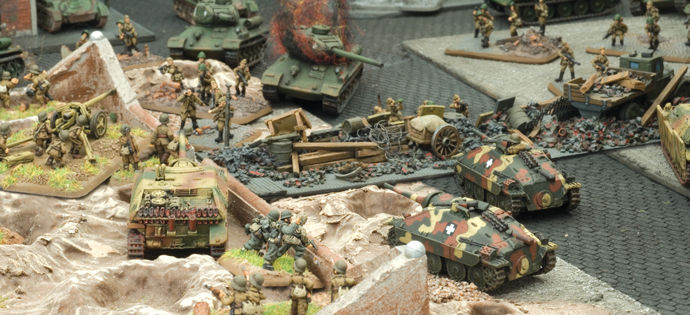 |
After withdrawing across the Danube River to Buda, Group Billnitzer helped relieve pressure on Buda from the west. Fighting in and around hills of the picturesque Buda suburbs was hard as the Red Army tightened its noose around the German and Hungarian positions.
|
The surviving members of Group Billnitzer joined
the breakout attempt on foot, their assault guns had all been knocked
out or disabled. General Billnitzer and the members of the Assault
Artillery Group made an attempt to escape from Castle Hill. General
Billnitzer and a small group of his men made it as far as the woods west
of Buda and headed towards the hills.
He soon inherited a rag-tag group of civilians,
Hungarian and German SS soldiers. Billnitzer group was captured near the
village of Perbál, about 19km (12 miles) west of Budapest. Only a few
men of Group Billnitzer made it west to the German lines, the rest were
either captured or killed.
Right: Vezérezredes (Lieutenant-General) Erno Billnitzer. |
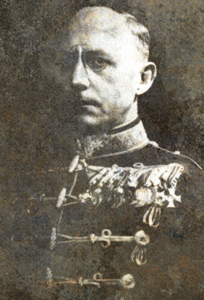
|
|
Jagdpanzer 38(t) ‘Hetzer’
Base Colour: Panther Yellow (FWP365).
|
Camo Colours: Boot Brown (FWP323); Army Green (FWP342).
|
Hungarian Assault Gun Crew Uniforms
The Assault Gun Crews were volunteers from the artillery and all were issued with standard khaki uniforms like any other
artillerymen. As part of the artillery branch their collar tabs were coloured red. However, because they were fighting in armoured vehicles they also adopted much of the additional uniform items available to tank and armoured car crews.
|
A. Dismounted Assault Gun Crew in light green mechanics overalls, often worn by the crew working inside the assault gun.
Colours: Tankovy Green (FWP341).
|
B. Dismounted Assault Gun Crew in leather jackets and trousers issued to armoured vehicle crews from 1941 and in the Italian style leather tank helmet.
Colours: Boot Brown (FWP323).
|
C. Dismounted Assault Gun Crew in blue-grey tank crew uniform introduced to all armoured units in 1943 and wearing a 43M peaked cap.
Colours: Infantry Blue (FWP400).
|
D. Dismounted Assault Gun Crew in standard Hungarian army uniform.
Colours: Battledress Brown (FWP325) This is one of the Hungarian NCO miniatures with a head swap where I’ve replaced his helmet with a peaked cap from a German.
|
You may be asking why paint up dismounted crew? I like to use them as Bailed Out markers instead of plastic tokens. I enjoy the look of the extra miniatures on the table. Casualty miniatures that are also available through the Special Order catalogue make excellent Pinned Down markers. The crew shown above will be available through the Special Order catalogue in the near future soon and come from the German and Italian ranges.
View the Special Order range in the online store here...
~ Wayne.
|
Last Updated On Wednesday, July 1, 2015
|
|
|